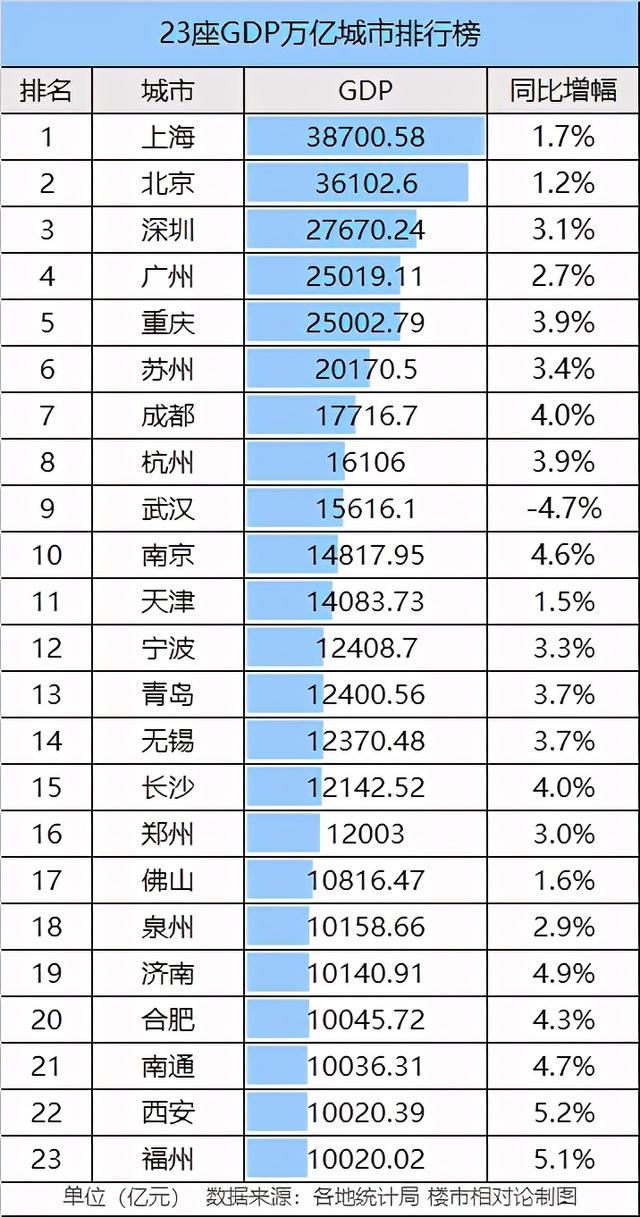Today (March 5), the government work report announced that my country’s GDP will grow by 2.3% in 2020.
The 2020 GDP data of various regions have also been released. The economic strength between cities has been shuffled again. The Trillion Club has added 6 new members. In 2020, a total of 23 cities will enter the ranks of trillions of GDP.
The 23 cities are: Shanghai, Beijing, Shenzhen, Guangzhou, Chongqing, Suzhou, Chengdu, Hangzhou, Wuhan, Nanjing, Tianjin, Ningbo, Qingdao, Wuxi, Changsha, Zhengzhou, Foshan, Quanzhou, Jinan, Hefei, Nantong, Xi’an , Fuzhou.

In addition, the GDP of 6 cities exceeded 2 trillion, namely: Shanghai, Beijing, Shenzhen, Guangzhou, Chongqing and Suzhou.
Six cities have become newly emerging cities with a trillion GDP: Quanzhou, Jinan, Hefei, Nantong, Xi’an and Fuzhou.
Among the top ten cities in terms of GDP, Shanghai ranks first in terms of total GDP, Shenzhen has a strong growth rate of 3.1% among the first-tier cities, and Shanghai, Beijing and Guangzhou are 1.7%, 1.2% and 2.7% respectively.
The total GDP of Chongqing and Guangzhou are very close.
Before the data was released, there were rumors in the market that Chongqing would surpass Guangzhou to become the fourth in total GDP. As a result, Guangzhou narrowly defeated and retained its position as the fourth city in the country’s GDP.
Chongqing and Guangzhou have formed a development trend of catching up with each other, and the gap between Chongqing and Guangzhou has been gradually narrowing in the past ten years.
However, from the perspective of development trends, Chongqing’s surpassing Guangzhou is just around the corner. Chongqing’s GDP growth rate in 2020 is 3.9% year-on-year, 1.2% higher than Guangzhou’s growth rate.
Judging from the fact that the 3D magical Chongqing broke the circle strongly and triggered the “check-in” craze, the development of the “net celebrity” city Chongqing is indeed not easy!
Wuhan suffered a severe impact from the epidemic in the first quarter of last year, with a year-on-year GDP growth of -4.7%, and still achieved a total GDP of 1,610.61 billion yuan, ranking ninth, with only a drop of two places in the ranking.
As the city with the longest lockdown period and the latest restart time, Wuhan’s GDP in the first quarter of 2020 dropped by 40.5% year-on-year. After the restart, Wuhan has stabilized its economic fundamentals and demonstrated strong recovery capabilities.
In 2021, the “Government Work Report” of Wuhan City proposes that the GDP of Wuhan will increase by 10% in 2021.
Wuhan, a new star in the middle reaches of the Yangtze River, is rising.
Tianjin unexpectedly dropped out of the top ten teams and changed positions with Nanjing, ranking eleventh.
Tianjin’s lagging behind has become another proof of the view of “strong south and weak north”. In the top ten rankings, Beijing became the only northern city.
Among cities with a trillion GDP, the Yangtze River Delta accounts for half of the total, with 8 cities on the list.
Among the cities of Jiangsu, Zhejiang and Shanghai, in addition to Shanghai, which occupies the top spot for many years, the Zhejiang team has two major cities, Hangzhou and Ningbo, and the “Bulk Jiangsu” has Suzhou in the top ten. Nanjing, Wuxi and Nantong are also strong markets. There are also reserve forces like Changzhou and Xuzhou.
In 2016, the State Council approved Hefei as China’s “Vice Central City of the Yangtze River Delta City Group”, and Hefei has become the backbone of a trillion cities in the Yangtze River Delta.
Both Quanzhou and Fuzhou in Fujian exceeded trillions. The total GDP of Quanzhou was 1015.866 billion, a growth rate of 2.9%, and that of Fuzhou was 10020.02 billion, a growth rate of 5.1%.
With Fuzhou’s growth rate, Quanzhou’s GDP and Fujian’s No. 1 position may change hands.
Xiamen ranks fourth in housing prices in the country and third in Fujian’s GDP, which is far from a trillion GDP. The total value in 2020 is 638.402 billion yuan, an increase of 5.7% over the previous year.
Jinan, the capital of Shandong Province, finally made a comeback for the north, with GDP breaking through the trillion mark, and together with Beijing, Tianjin, Qingdao, Zhengzhou, and Xi’an, it became the north’s economic responsibility.
Who is most likely to be the next city with a trillion GDP?
Looking around the north and south, Changzhou, Xuzhou, Dalian and other 700 billion-level cities are still far away from the promotion. At present, the city most likely to advance to the next trillion GDP is Dongguan, Guangdong.
In 2020, the GDP of Dongguan City in Guangdong reached 965.19 billion yuan, a year-on-year growth rate of 1.1%, standing at the door of a trillion GDP.
Dongguan is a well-known “world factory” with a well-developed electronic information manufacturing industry. Coupled with Huawei’s relocation from Shenzhen to Songshan Lake in Dongguan, Dongguan has great potential to move towards a trillion GDP.
In the ridicule of “Come to Shenzhen, Dongguan and Huizhou people”, Dongguan not only undertakes Shenzhen’s industrial spillover, but also accommodates talents from Shenzhen.
Even 2020
The property market is a mirror that reflects economic development, reflecting the potential city of Dongguan.
Of course, for some cities whose housing prices are too high and their GDPs have not kept up, they have overdrawn the room for housing prices and have to wait for economic development to come and go bubble.
Conclusion
Among the 23 trillion GDP cities, only Shanghai, Beijing, Tianjin, Wuhan and Foshan will have GDP growth rates lower than the national level in 2020. Most cities have maintained high growth rates and are economically resilient.
This morning, the government report stated:
The economic growth rate is a comprehensive indicator. The expected GDP target for this year is set at more than 6%. Taking into account the recovery of economic operations, it is conducive to guiding all parties to focus on promoting reform and innovation and promoting high-quality development.
In 2021, which cities will have a GDP of one trillion?
let us wait and see.